Looking to brighten up your outdoor spaces? It’s crucial to choose fixtures that are suitable for different outdoor conditions, considering factors like weather exposure, wildlife impact, and energy efficiency. Exterior lights play a significant role in enhancing architectural features and outdoor spaces by improving security, landscape design, and creating dramatic effects. The ultimate guide to outdoor lighting covers everything from selecting fixtures and bulbs to planning your design and installing with safety in mind. This guide will help you create a safe, beautiful, and functional outdoor area, all while being energy efficient.
Key Takeaways
- Choose the right outdoor lighting fixtures—path lights, accent lights, wall lights, and flood lights—to enhance safety, aesthetics, and functionality in your outdoor spaces.
- Careful planning and placement of outdoor lighting can create an inviting atmosphere while boosting security and usability after sunset.
- Opt for security lights to enhance safety and protection for your outdoor spaces. These lights, often equipped with motion sensors, can deter intruders and provide illumination in areas like entryways and pathways, emphasizing the importance of thoughtful lighting design for security purposes.
- Ensure the front door is well-lit to enhance safety and accessibility. Effective lighting at the front door can improve the experience of approaching your home and deter potential intruders.
- Place wall sconces near the garage door to enhance visibility and aesthetics. Properly positioned wall sconces can improve the appearance of your home from a distance and provide better illumination.
- Opt for energy-efficient lighting solutions like LED and solar-powered lights to reduce energy consumption and minimize environmental impact, all while ensuring your outdoor areas are beautifully illuminated.
Basics of Outdoor Lighting
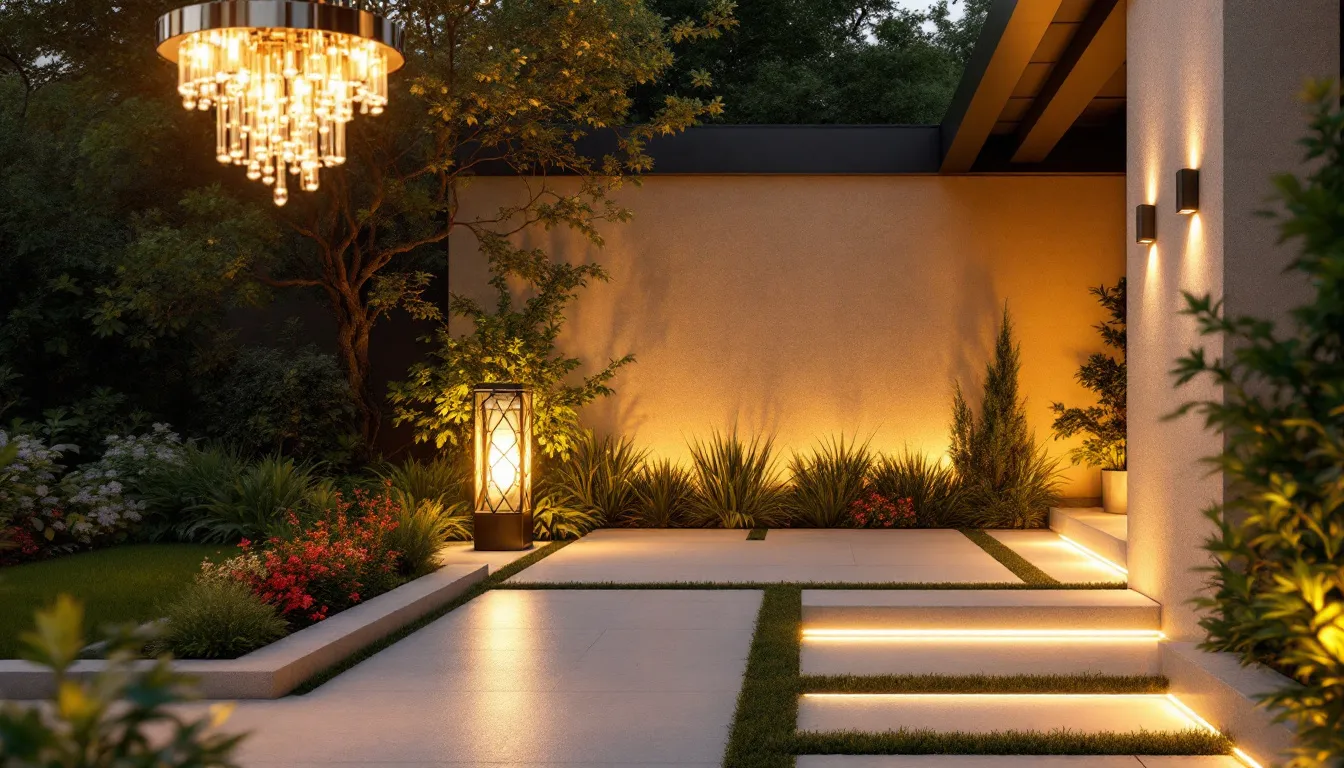
Outdoor lighting is designed to brighten up areas, boost aesthetic appeal, and enhance practicality through the appropriate use of outdoor lighting advantage and exterior illumination. The correct placement of outdoor lights can also highlight architectural elements, adding dramatic visual effects to your landscape. Planning outdoor lighting is such a great idea for enhancing both aesthetics and functionality.
There are various types of outdoor lighting fixtures with specific functions such as:
- Path lights
- Accent lights
- Wall lights
- Flood lights
When you select the right fixtures and position them thoughtfully, they can elevate your outdoor area into an inviting and visually attractive space. The correct placement of outdoor lights brings attention to key features in your landscape, making it more welcoming. To make sure that the lighting enhances your outside setting, when choosing outdoor lamps or other forms of lighting, consider how each part will be utilized and match these choices with both the architectural style of your home and personal taste. Additionally, avoid using harsh blue lights to protect local wildlife and reduce light pollution.
Types of Outdoor Lights
Outdoor lighting encompasses a variety of light fixtures designed to illuminate and enhance an outdoor space. These include:
- Path lights that ensure pathways and entryways are well-lit, offering both functionality and aesthetic appeal
- Accent lighting which serves to draw attention to specific features within your garden or yard
- Wall-mounted lights that contribute to creating a pleasant atmosphere in your external areas and are crucial for lighting the front door for safety and accessibility
- Floodlights meant for casting wide beams of light across expansive spaces
- Landscape lights that enhance the aesthetics and safety of outdoor spaces by highlighting architectural features and ensuring seamless illumination
- Outdoor ceiling lights suitable for covered patios and porches, optimizing light in areas such as porches, patios, or eaves
Regularly spaced path lights along walkways help improve visibility while also adding safety.
Accent lights bring dramatic flair by spotlighting eye-catching elements like artwork or distinctive plants. To evoke the warm glow of candlelight, lamps resembling candles can serve as unique accent lighting options, fostering a cozy ambiance.
Wall sconces provide illumination on walls and nearby regions. These wall fixtures are commonly situated near doorways where they fulfill functional needs whilst enhancing visual charm. They should also be positioned near the garage door to enhance visibility and aesthetics. For heightened security measures, floodlights offer broad-spectrum lighting perfect for delineating property boundaries or safeguarding structures against potential intruders. Integrating various types of light fittings with floodlights can significantly elevate the mood within an environment.
Selecting appropriate outdoor lights is key in achieving both practicality and stylishness throughout one’s exterior living quarters.
Benefits of Outdoor Lighting
Outdoor lighting offers more than just the ability to see in the dark. It significantly improves safety by shedding light on potential risks present within your property. By preventing shadowy areas, this type of lighting serves as an effective preventive measure against both wildlife intrusions and criminal activity, thereby strengthening overall security. A well-lit exterior enhances safety and extends the functional time frame of outdoor spaces well into the evening hours, making them perfect for hosting gatherings or enjoying some peaceful leisure time after dusk.
Following are key advantages provided by outdoor lighting:
- It increases yard safety through heightened visibility.
- It deters unwanted animals and trespassers while reducing obscured areas that may compromise security.
- It enhances how long you can utilize outside areas during nighttime for socializing and unwinding.
Carefully designed illumination not only highlights aesthetic elements such as trees and flower beds, but also contributes to forging a welcoming ambiance outdoors. The principal perks encompass improved safety measures, elevated appeal from curbside perspectives, enhanced valuation of real estate properties, and expanded functionality of exterior living zones. Additionally, understanding local environmental conditions and how natural lighting influences wildlife behavior is crucial. Minimizing light pollution and mimicking natural lighting can protect the ecosystem.
Choosing the Right Light Bulbs
Selecting appropriate bulbs for your outdoor lighting is key to creating the desired mood and achieving perfect lighting. Choosing the right bulbs, such as high-quality LED options, contributes to perfect lighting by ensuring both functionality and ambiance. LED bulbs are often chosen for their extended lifetime, offering up to 50,000 hours of use, as well as their significant energy-saving capabilities compared to traditional options. Although halogen bulbs surpass incandescent ones in terms of saving energy, they still fall short with a much more limited lifespan at roughly 2,000 hours.
Outdoor usage typically isn’t suited for compact fluorescent lights unless they’re specifically tailored for such conditions. For brightening expansive outside areas effectively, High-Intensity Discharge (HID) lamps stand out due to their superior light output capacity. Choosing energy-efficient bulbs, such as those with motion-sensors or solar-powered options, can also help save energy in your outdoor lighting setup.
The atmosphere conveyed by outdoor lighting can vary greatly depending on bulb color temperature: warmer hues tend to evoke a snug vibe whereas cooler tones may boost safety features around your space. Always opt for light fixtures and bulbs that are expressly intended for exterior applications since utilizing those made strictly for indoor purposes outdoors could create potential hazards along with subpar performance and diminished durability.
Planning Your Outdoor Lighting Design
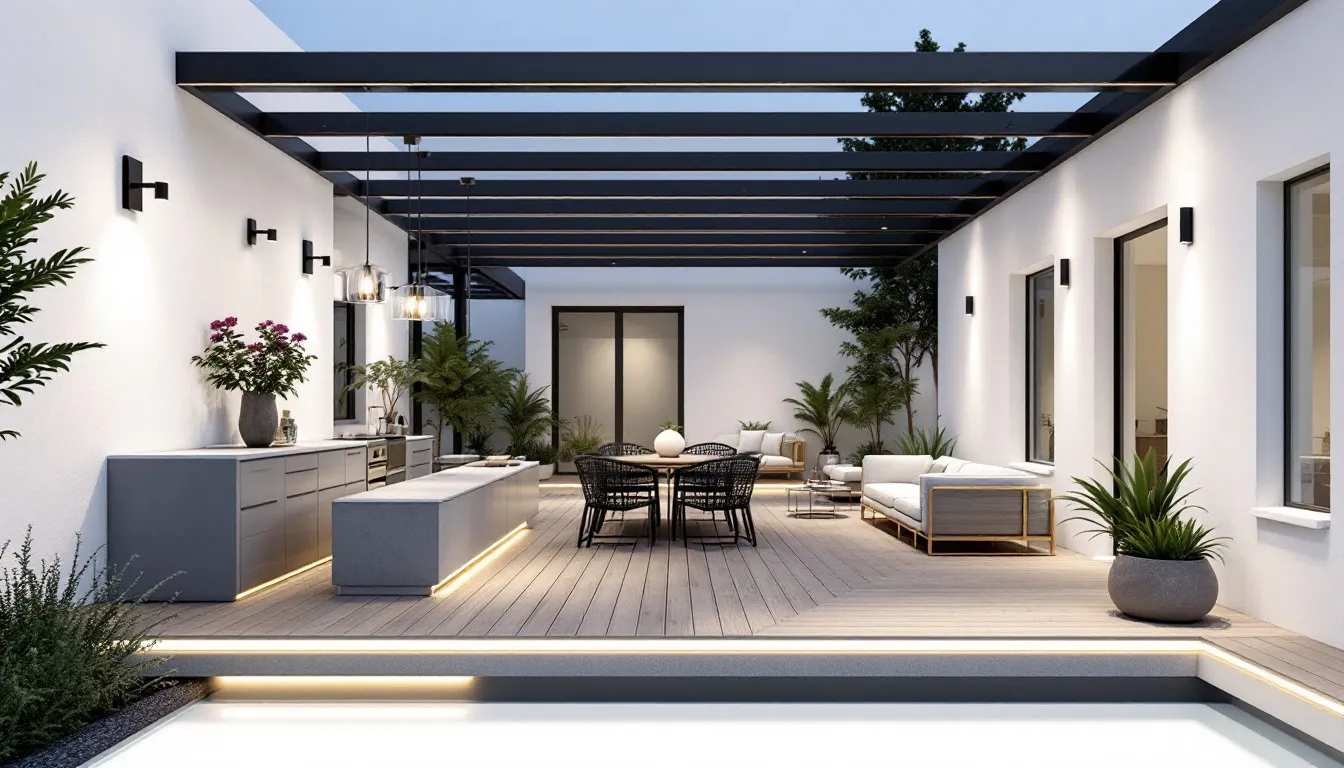
Designing your outdoor lighting is essential to converting your yard into a captivating retreat. As the homeowner, you are ideally positioned to orchestrate an outdoor lighting system tailored specifically for your yard’s distinct characteristics and align with your individual tastes.
To achieve optimal results in outdoor lighting, strategic planning regarding the placement of fixtures and their functional roles is necessary. By accentuating focal points and harmoniously blending various strata of light sources, you can significantly elevate both utility and beauty within your external area through impeccable illumination. Strategic lighting can also be used for highlighting architectural elements, such as columns or intricate stonework, enhancing their visual appeal. Consider this narrative as an ultimate guide to crafting perfect outdoor lighting.
Creating visual interest through lighting can enhance the aesthetic appeal of outdoor spaces, making them more inviting and visually captivating.
For more compact yards, options such as deck lights or strings of bulbs may suffice. Meanwhile, expansive areas might necessitate broader deck lighting solutions that effectively cover larger stretches.
Assessing Your Outdoor Space
The initial phase of crafting an outdoor lighting plan involves a thorough examination of your outdoor space. Scrutinize elements like pathways, decks, garden beds, and areas designated for outdoor living to pinpoint precise requirements for illumination. Employ various lighting methods such as uplighting, downlighting, and task lighting to enhance the functionality and aesthetic appeal of these spaces. Certain fixtures are designed to minimize light pollution by being light directed, focusing illumination toward the ground.
For areas that witness substantial foot traffic, opt for brighter lights to ensure safety. Conversely, gentle illumination is more fitting in laid-back settings. Security lights, often equipped with motion sensors, can enhance safety by deterring intruders and providing illumination in areas like entryways and pathways. Additionally, lighting the front door is crucial for safety and accessibility, enhancing the experience of approaching the home.
It’s important to steer clear of situating lights in locations where they might encounter.
- Lawn mowers or weed whackers
- Direct exposure to rain
- High wind conditions
- Water accumulation
Incorporate subtle spotlights at ground level along driveways as a means to provide clear visibility and facilitate safe movement through these entry points. Consider placing these spotlights near the garage door to enhance visibility and aesthetics, ensuring they look appealing from a distance.
Creating a Lighting Plan
Developing an outdoor lighting scheme requires you to identify and map the elements of your property that will benefit from illumination. Your plan should include a diagram indicating where each light fixture will be situated, along with their respective power sources. To ensure uniform distribution of light, lights placed along pathways ought to be positioned at intervals ranging from 6 to 10 feet. It is also crucial to select damp-rated fixtures for covered patios, as these areas are protected from direct rain but still exposed to outdoor elements.
Implementing intelligent outdoor lighting systems allows for programming on a timetable, offering both ease and energy efficiency. With meticulous planning of your lighting strategy, it’s possible to establish an integrated and practical setup that elevates the appeal and functionality of your outdoor space. Planning outdoor lighting is such a great idea for enhancing both aesthetics and functionality. Additionally, selecting appropriate lighting for a covered porch is essential, considering the height of the space and the environmental factors affecting durability.
Balancing Aesthetics and Functionality
It is essential to achieve a harmony between visual appeal and practicality within outdoor lighting design. The considerations for outdoor lighting are comparable to those for indoor lighting, as both aim to enhance safety and security around one's home. The variety of outdoor lights should align with the architectural aesthetics of your residence to establish uniformity. By strategically positioning lights at various elevations and viewpoints, one can add richness and perspective to the exterior areas.
Incorporating motion sensors and timers into an outdoor lighting scheme plays a significant role in avoiding wasteful energy consumption by activating the lights solely when required. A well-executed plan for illumination not only enhances the beauty of your surroundings, but also promotes safety while bolstering energy conservation efforts, contributing to overall energy savings. Additionally, creating an inviting atmosphere through well-placed and selected lights enhances the beauty and functionality of outdoor spaces, making them more appealing and navigable.
Installation Tips for Outdoor Lighting
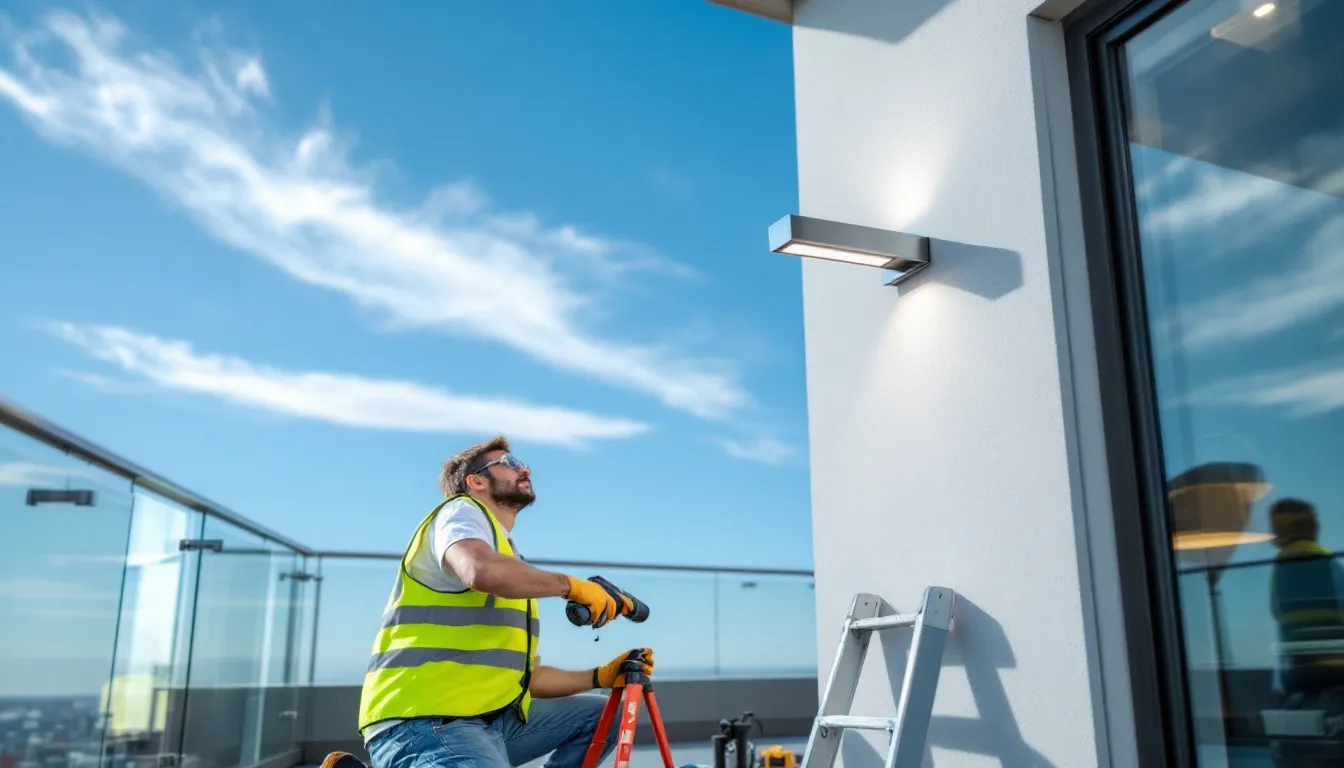
It’s crucial to choose fixtures that are suitable for different locations and install outdoor lighting fixtures properly for them to serve their purpose effectively and ensure safety. The suitability of a lighting fixture for various locations is determined by its weather resistance rating, which classifies it as either damp or wet.
When installing outdoor lighting, prioritizing safety is paramount. This includes taking essential precautions such as shutting off the power source to avoid electrical risks. Whether you opt to personally handle the installation of your outdoor lighting or engage a professional should be based on the project’s complexity and scale, along with your own level of skill and experience.
Outdoor ceiling lights are an excellent option for covered areas like porches, patios, or eaves. They optimize light distribution and require selecting the appropriate type based on their wet or damp location ratings.
Wall-mounted lights are essential for lighting the front door, enhancing safety and accessibility for anyone approaching your home.
Wall sconces should be positioned near the garage door to enhance visibility and aesthetics, ensuring they look good from a distance.
Safety Tips for Installation
Safety should be the foremost concern when setting up outdoor lighting. It’s essential to adhere to all required safety steps, including shutting off electricity at its source before beginning installation, in order to avoid any electrical risks.
Additionally, it is important to avoid using harsh blue lights to protect local wildlife and reduce light pollution. These lights can be harmful to animals, particularly turtles, and can disrupt natural behaviors such as egg-laying.
By observing appropriate safety protocols, you not only safeguard yourself, but also contribute to the extended durability and improved functionality of your outdoor lighting system.
DIY vs. Professional Installation
Determining whether you should undertake the installation of outdoor lighting on your own or engage a professional hinges on the project’s intricacy and magnitude, alongside your individual level of skill. It is crucial to choose fixtures that are suitable for the specific environmental conditions where they will be installed. Typically, homeowners are capable of managing basic installations such as solar-powered lights or fixtures that simply plug in without much difficulty.
Nevertheless, it is recommended to employ an expert for projects involving wired systems or significant alterations, particularly in instances where electrical tasks fall outside your comfort zone.
Regular Maintenance
To preserve the durability of your outdoor lighting arrangements, consistent upkeep is crucial to ensure a well-lit exterior. This involves tasks such as tidying up light fixtures, substituting non-working bulbs, and undertaking periodic inspections. When carrying out these seasonal examinations, it’s important to ensure that all lights are in working order and to look for any potential risks like wires that may be uncovered.
By promptly swapping out failed bulbs, you guarantee even lighting coverage across your exterior areas. This not only improves the visual appeal but also boosts safety by providing adequate illumination.
Advanced Outdoor Lighting Features
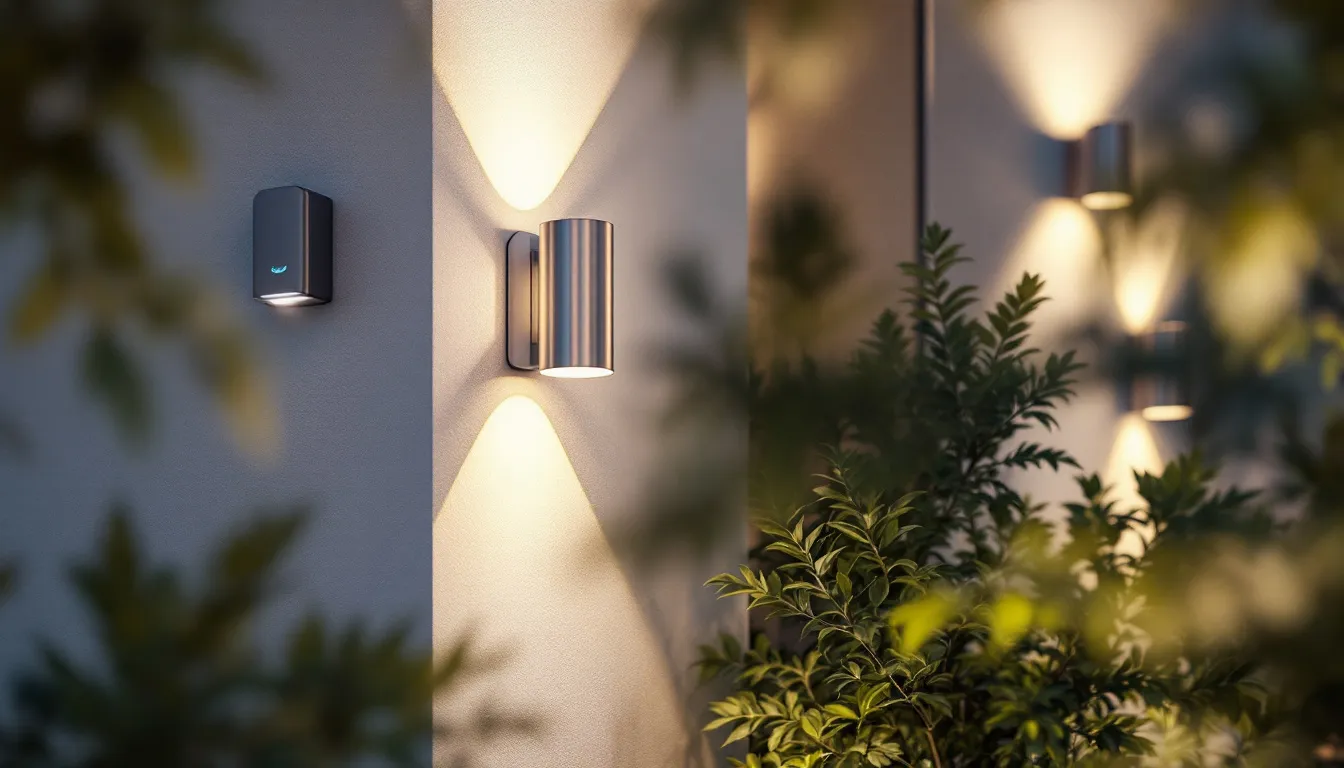
Innovative features in outdoor lighting, such as security lights with advanced motion sensors, can greatly improve the usability, comfort, and safety of your exterior areas. Techniques like moon lighting, which mimics the natural glow of moonlight by placing light fixtures high within trees to cast light on their branches, are examples of these enhancements.
Your outdoor lighting design can be taken to the next level with additions such as motion sensor lights, solar powered lights, and intelligent outdoor lighting systems. These advanced features contribute to achieving perfect lighting by ensuring high-quality illumination tailored to various environmental conditions and fixture types.
Motion Sensor Lights
When movement is sensed, motion sensor lights are triggered, serving to ward off potential trespassers and bolster outdoor safety. To achieve maximum protection, it’s best to position these lights in areas such as near doors, along driveways, or on walkways. Placing motion sensor lights near the front door is crucial for safety and accessibility, ensuring a well-lit entrance. Similarly, positioning them near the garage door enhances visibility and aesthetics. They also come with sensitivity adjustments that can be tailored to suit different environments for optimal performance.
The inclusion of motion sensor lights improves both the security aspects and the functionality of your overall outdoor lighting setup. Additionally, these lights help save energy by only activating when needed, making them an efficient choice for maintaining energy efficiency.
Solar Powered Lights
Eco-friendly solar powered lights offer a versatile solution for outdoor illumination without the necessity of wiring, enabling placement in locations without electrical outlets. These lighting solutions can brighten even remote or difficult-to-access areas.
Harnessing energy from the sun to power these lights is not only sustainable, but also contributes to lower energy expenses, helping to save energy and establishing solar powered lights as a prudent choice for exterior lighting needs.
Smart Outdoor Lighting Systems
Users can manage smart outdoor lighting systems through their smartphones, controlling aspects like brightness, hue, and when the lights turn on or off. This programmability adds to both ease of use and home safety by adhering to personalized schedules.
By integrating smart lighting control into these systems, homeowners have the ability to fine-tune energy consumption according to their requirements. Smart lighting systems help save energy by allowing precise control over when and how lights are used. When connected with security cameras and other intelligent household devices, smart outdoor lighting contributes significantly to improving overall home security.
Enhancing Landscape Elements with Lighting
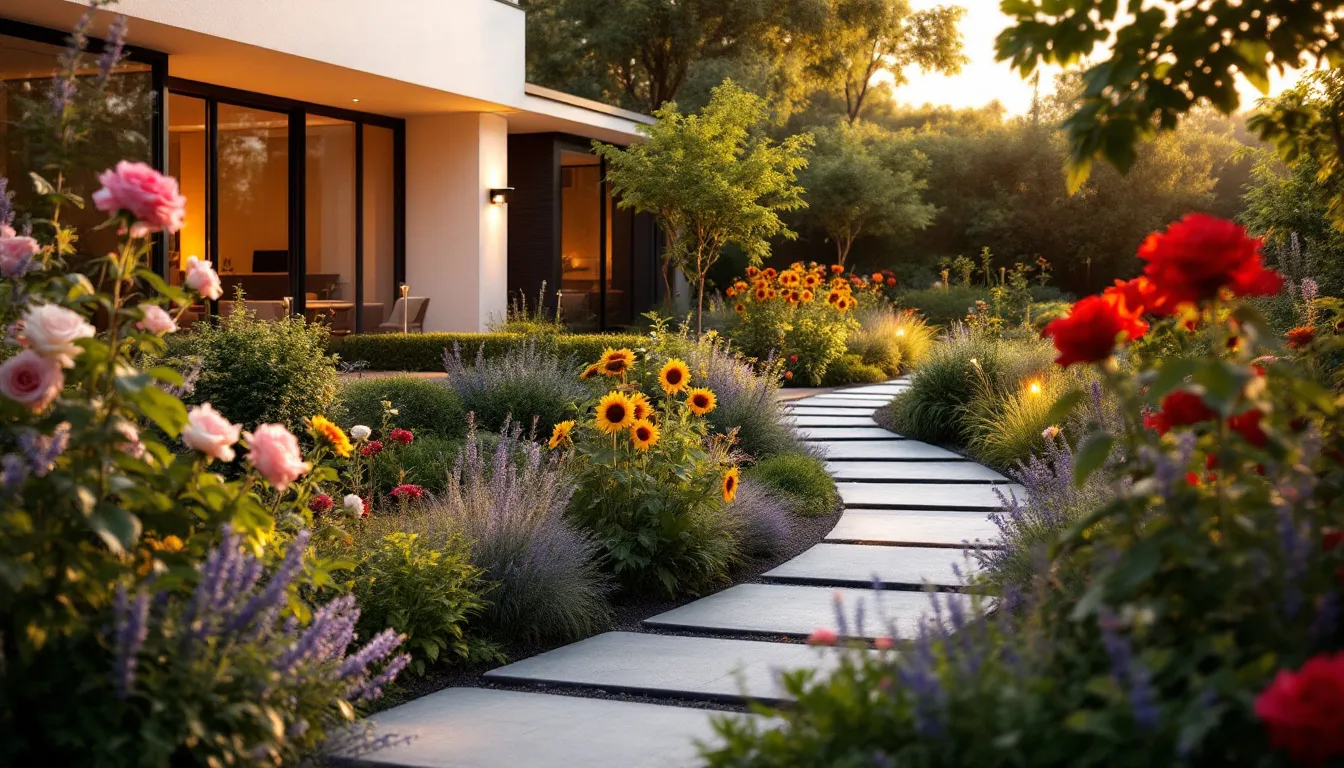
A well-crafted plan for outdoor lighting acts as a strategic guide to light up exterior areas, simultaneously improving both safety and visual appeal by highlighting architectural elements.
Employing methods such as:
- wall-wash lighting
- grazing
- shadowing
- silhouette lighting
One can achieve impressive visual impacts.
The use of in-ground lights is an excellent way to accentuate prominent landscape elements like trees and walls, while wall washers bring out the intricate details in textures and building materials. By embedding lights into stair risers, one not only increases safety, but also elevates the attractiveness of outdoor steps. Creating visual interest through strategic lighting enhances the aesthetic appeal of landscape elements, making the overall ambiance more captivating.
Pathway and Garden Lighting
Illuminating walkways with landscape lights such as path and spread lighting not only increases safety by ensuring clear visibility, but also contributes to an appealing environment by adding a touch of visual flair. By focusing light downward along garden paths, one can facilitate safer movement while simultaneously enriching the aesthetic appeal. Path lights are also essential for lighting the front door, enhancing safety and accessibility for anyone approaching the home.
Strategically placed path lights are crucial for enhancing both visibility and security on walkways as well as for injecting charm into outdoor spaces. These lights serve the dual purpose of aiding in navigation and crafting a welcoming ambience through their intentional placement. Light directed downward enhances safety and reduces light pollution, making it an environmentally friendly choice. Additionally, placing path lights near the garage door can enhance visibility and aesthetics, ensuring a cohesive and attractive look from a distance.
Highlighting Architectural Features
Spotlighting specific focal points within your landscape, including unique architectural features or trees, can greatly elevate their aesthetic impact. In the realm of outdoor lighting design, spotlights are commonly employed for highlighting architectural elements, such as columns or intricate stonework, to accentuate distinct aspects like statues, vegetation, and building designs.
When it comes to creating a captivating environment and introducing dimensionality to your exterior areas, emphasising architectural features is key. By tactically deploying spotlights and wall washers on these highlighted elements you can achieve remarkable visual effects that significantly enhance the atmosphere by bringing attention to the architecture’s details.
Deck and Step Lighting
Illumination for outdoor staircases is crucial not only for improving safety but also to ensure each step is well-lit, thereby reducing the risk of slips or trips in dimly lit areas. Deck and step lights are instrumental in achieving this.
Outdoor ceiling lights are also a suitable option for illuminating decks and steps, especially when installed against ceilings or eaves. They optimize light in outdoor areas and should be chosen based on their wet or damp location ratings.
Post lights serve a dual purpose by contributing to the aesthetic charm of your external environments. They create an alluring ambiance that makes evening social events more welcoming and warm.
Energy Efficiency and Environmental Considerations
Energy-efficient outdoor lighting is crucial for minimizing energy usage and reducing light pollution. Using energy-efficient lighting helps save energy and reduce costs. Selecting the right outdoor light bulbs should take into account the desired ambiance and efficiency for the space. Motion sensor lights provide energy savings by only activating when motion is detected, making them a more eco-friendly option.
It is also important to avoid harsh blue lights to protect wildlife and reduce light pollution. Solar-powered lighting systems draw energy from the sun, making them a sustainable choice for outdoor illumination. Switching to energy-efficient lighting reduces greenhouse gas emissions linked to fossil fuel-generated electricity.
LED and Solar Options
LED lights are capable of using up to 80% less energy than traditional incandescent bulbs and offer a greater lifespan, helping to save energy. They also boast environmental advantages such as operating on low voltage, having durable build quality, and performing well in harsh weather conditions.
Utilizing solar lighting removes the requirement for transformers and enables self-sufficiency in terms of energy by harvesting it throughout daylight hours. By integrating LED with solar light solutions, significant reductions can be achieved in the amount of energy consumed within outdoor spaces.
Dark Sky Compliance
Fixtures that comply with dark sky standards aim to reduce light pollution by ensuring that illumination is light directed downward. Such compliance plays a key role in diminishing the negative impact of light pollution on our environment, as these fixtures aid in avoiding undue glare, thereby improving visibility and comfort within outdoor spaces.
These compliant fixtures serve an important function in maintaining natural nocturnal environments, supporting the well-being of surrounding ecosystems while also enhancing the beauty of nighttime landscapes.
Sustainable Practices
Adopting eco-friendly practices for outdoor lighting not only helps save energy but also extends the life of your lighting fixtures. By incorporating timers and motion sensors, you can prevent wasteful usage by ensuring that outdoor lights are active only when required.
Opting for LED bulbs and solar powered lights greatly decreases the amount of energy used, contributing to a more sustainable approach to your outdoor lighting design. Selecting robust, weatherproof fixtures guarantees that your outdoor lighting system operates effectively and remains in good condition over time, bolstering its sustainability.
Summary
Outdoor lighting is an essential aspect of creating a welcoming, safe, and aesthetically pleasing outdoor environment. Well-placed and selected lights contribute to an inviting atmosphere, making outdoor spaces more appealing and navigable. By understanding the basics of outdoor lighting, planning a thoughtful design, installing fixtures safely, exploring advanced features, and considering energy efficiency, you can transform your outdoor spaces into enchanting and functional areas. Achieving perfect lighting enhances the beauty and functionality of outdoor spaces, ensuring they are both inviting and practical. Remember, the right lighting not only enhances the beauty of your landscape, but also promotes safety and sustainability. So go ahead and illuminate your world, one light at a time.
Frequently Asked Questions
What are the benefits of outdoor lighting?
Outdoor lighting significantly improves safety and boosts curb appeal, making your property more inviting and valuable.
Embrace the transformation and enjoy your outdoor spaces longer!
How do I choose the right light bulbs for outdoor lighting?
When selecting light bulbs for your outdoor space, it is recommended to go with LED options due to their superior energy efficiency and long life. You should pick a color temperature that aligns with the atmosphere you wish to create—choose warmer tones for a cozy vibe or cooler tones if your aim is improved security.
Embrace the change and bring new vibrancy to your outdoor area!
Should I install outdoor lighting myself or hire a professional?
Installing outdoor lighting yourself can be a rewarding DIY project for simpler setups, but for more complex or wired systems, hiring a professional ensures safety and quality.
Trust your instincts—if it feels overwhelming, don’t hesitate to seek expert help!
What are dark sky compliant fixtures?
Dark sky compliant fixtures are essential for protecting our night skies as they effectively minimize light pollution by directing light downward.
Choosing these fixtures helps preserve the beauty of nighttime while enhancing safety and visibility in your surroundings!
How can I make my outdoor lighting more energy-efficient?
To make your outdoor lighting more energy efficient, switch to LED and solar-powered lights, and incorporate timers and motion sensors.
These steps will not only cut energy consumption, but also promote a sustainable lifestyle

